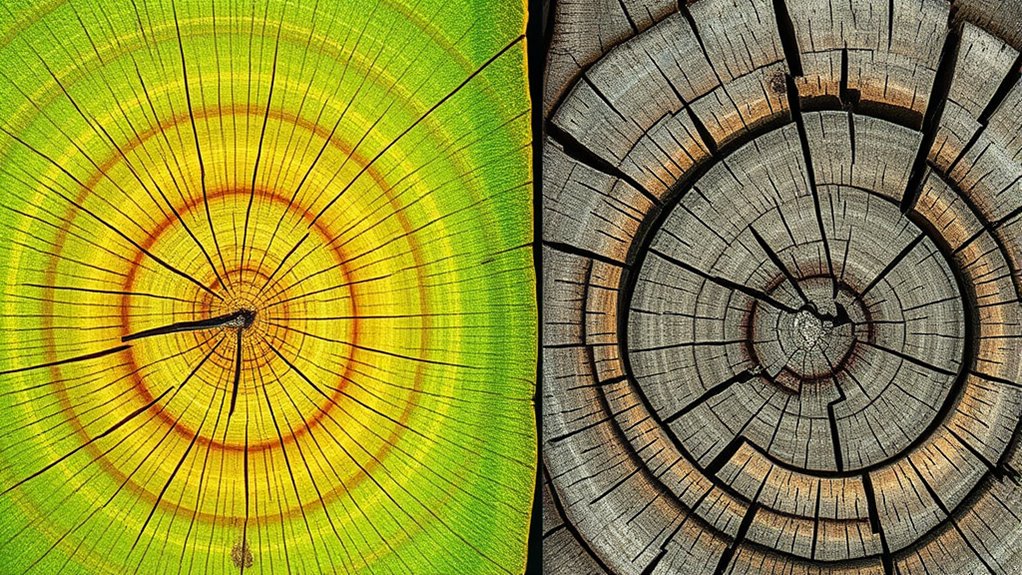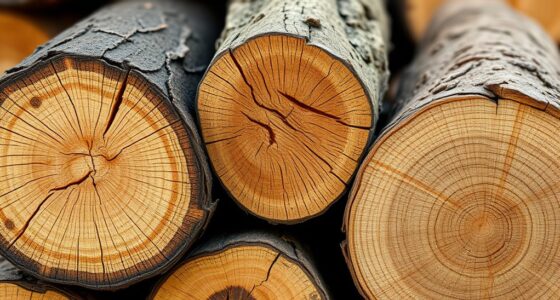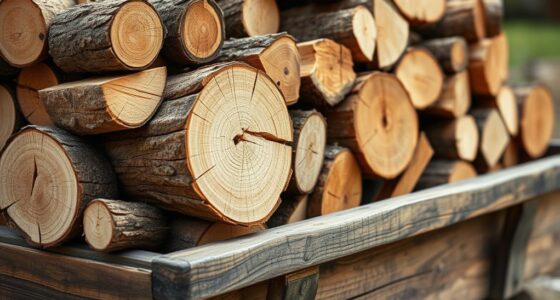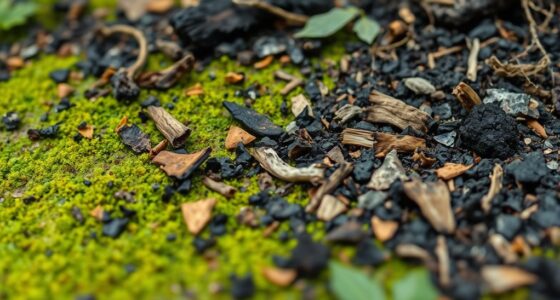Green wood still contains a lot of moisture, making it hard to ignite and causing more smoke and creosote in your chimney. Seasoned wood is dried properly, with lower moisture, so it burns hotter, cleaner, and more efficiently. Using seasoned wood reduces creosote buildup and makes fires easier and safer to start. If you want to know how to tell if your wood is properly seasoned or how it impacts your fire, just keep going.
Key Takeaways
- Green wood has high moisture content (>60%), making it harder to ignite and less efficient than seasoned wood.
- Properly seasoned wood has moisture levels around 20%, burns hotter, cleaner, and produces less smoke.
- Burning green wood leads to increased creosote buildup, risking chimney fires and reducing safety.
- Seasoned wood burns more efficiently, generating more heat and requiring less effort to start fires.
- Aging wood reduces moisture content naturally, improving fire safety, efficiency, and overall burn quality.

When choosing firewood, understanding the difference between seasoned and green wood is essential, as it directly affects how well your fire burns. The key factor here is moisture content, which markedly impacts the fire’s efficiency, heat output, and ease of ignition. Green wood, freshly cut from a tree, contains a high moisture content, sometimes exceeding 60%. This moisture impact makes it difficult to ignite and causes the fire to produce more smoke and creosote buildup in chimneys. On the other hand, seasoned wood has been properly dried, reducing its moisture level to around 20% or less, making it much easier to burn and more efficient in heat production.
The process of wood aging plays a vital role in reducing moisture. When you allow wood to age or season properly, the moisture naturally evaporates from the wood fibers, resulting in a lighter, drier piece of fuel. This aging process can take anywhere from six months to a year, depending on the wood type and storage conditions. During this period, the moisture impact decreases considerably, and the wood becomes more stable for burning. Properly seasoned wood burns cleaner, generates more heat, and produces less creosote, which can be a fire hazard if accumulated in chimneys. Additionally, moisture content is a critical factor in determining how well the wood will burn, affecting both safety and efficiency.
If you try to burn green wood, you’ll notice it’s stubborn to ignite and often produces a lot of smoke. The high moisture content absorbs much of the heat from your fire, preventing the wood from reaching the temperatures needed for efficient combustion. This results in a less hot fire, more soot, and a lot of wasted energy. Over time, burning green wood can lead to creosote buildup in your chimney, increasing the risk of dangerous chimney fires. Conversely, seasoned wood ignites quickly, burns hotter, and produces less smoke, making your fire more enjoyable and safer.
Understanding the importance of moisture impact and wood aging helps you make smarter choices when selecting firewood. Properly seasoned wood may take longer to prepare, but it pays off in better heat output, less smoke, and fewer maintenance issues. By giving your wood enough time to age and dry thoroughly, you’re ensuring a more efficient burn and prolonging the life of your stove or fireplace. Ultimately, investing in seasoned wood means you’re choosing fuel that’s optimized for safety, efficiency, and comfort, which makes every fire you light more satisfying.
Frequently Asked Questions
How Does Moisture Content Affect Wood Burning Efficiency?
Moisture content directly affects your wood burning efficiency by lowering combustion temperature and reducing heat output. When your wood has high moisture, it has lower density, making it harder to ignite and burn evenly. This results in more smoke and less heat. To maximize efficiency, choose seasoned wood with low moisture content, ensuring higher combustion temperature and better energy transfer, so you get more warmth from each burn.
Can Green Wood Cause Damage to Your Fireplace or Stove?
Green wood can definitely cause damage to your fireplace or stove. When you burn green wood, it produces more creosote, which can buildup and lead to chimney fires. It also creates excessive moisture, risking corrosion and cracking in your fireplace or stove. You might also experience inefficient burning, smoke buildup, and potential structural damage over time. Always use properly seasoned wood to keep your fireplace safe, efficient, and long-lasting.
What Signs Indicate Wood Is Properly Seasoned?
You’ll know wood is properly seasoned if it feels lightweight and has low moisture content. Look for dense, dry wood that sounds hollow when tapped and has cracks or splits in the ends. Use seasoning methods like air drying or kiln drying to reduce moisture. Properly seasoned wood has a lower density of water, burns cleaner, and produces more heat, making your fire more efficient and less smoky.
How Long Does It Typically Take for Wood to Season?
They say “patience is a virtue,” and that’s true when it comes to wood seasoning. Typically, it takes 6 to 12 months for wood to season naturally, depending on wood density and climate. Kiln drying speeds up this process, reducing it to a few days or weeks. You’ll want to check moisture content regularly—properly seasoned wood usually has 20% moisture or less for ideal burning and safety.
Is Moisture Content Measurement Necessary for All Types of Wood?
Moisture testing is essential for all types of wood to make certain proper drying and safe use. You should measure moisture content regularly, especially when using wood for burning or construction. Using effective wood drying techniques, like air drying or kiln drying, helps reduce moisture levels. By testing moisture content, you prevent problems like cracking or mold, ensuring your wood stays durable and performs well over time.
Conclusion
Choosing seasoned wood over green is like revealing a secret to perfect fires—moisture content makes all the difference. Green wood is a stubborn, stubborn foe that refuses to burn efficiently, wasting your time and effort. By drying your wood properly, you’ll enjoy blazing fires that light up your space effortlessly. Don’t settle for less; moisture content is the magic key that turns a good fire into an unforgettable one. Trust me, your wood will thank you!











